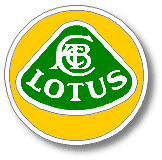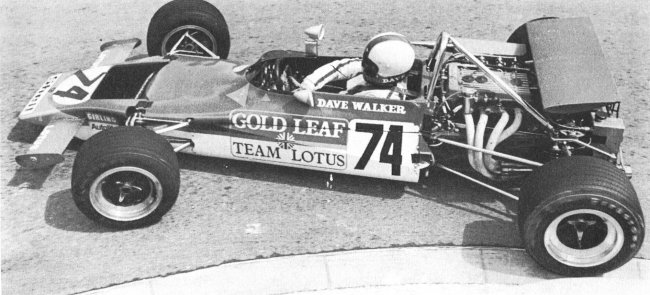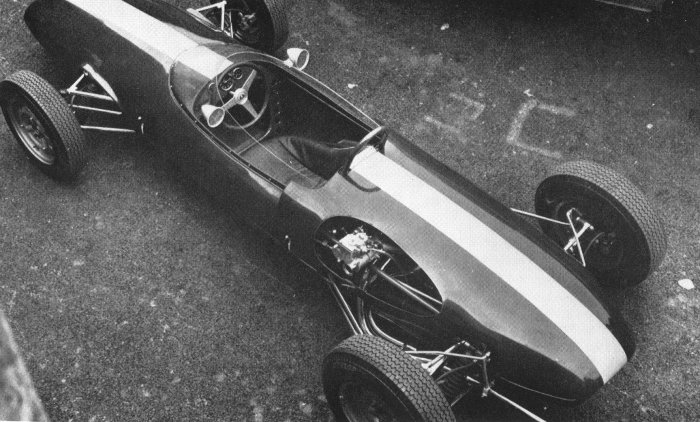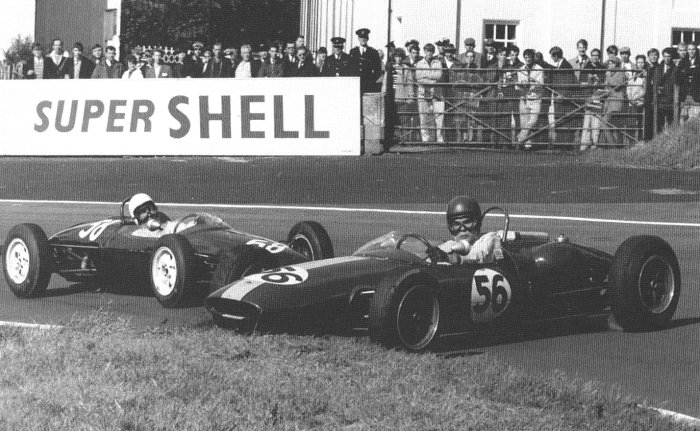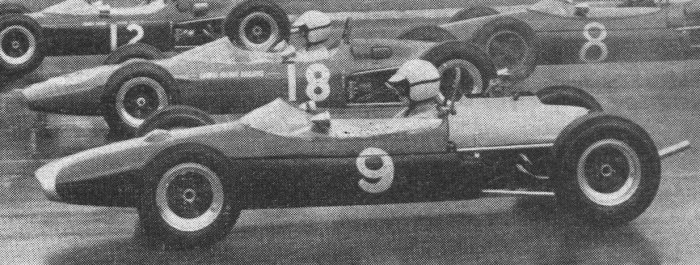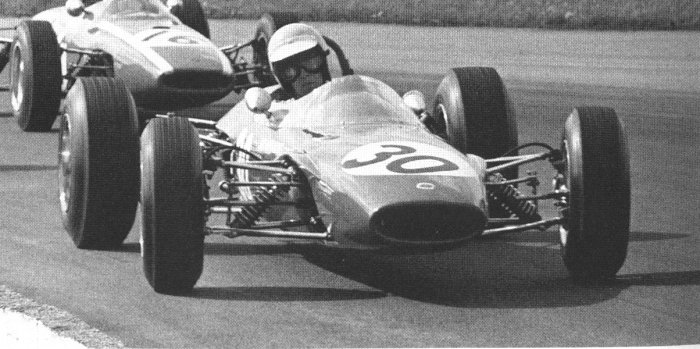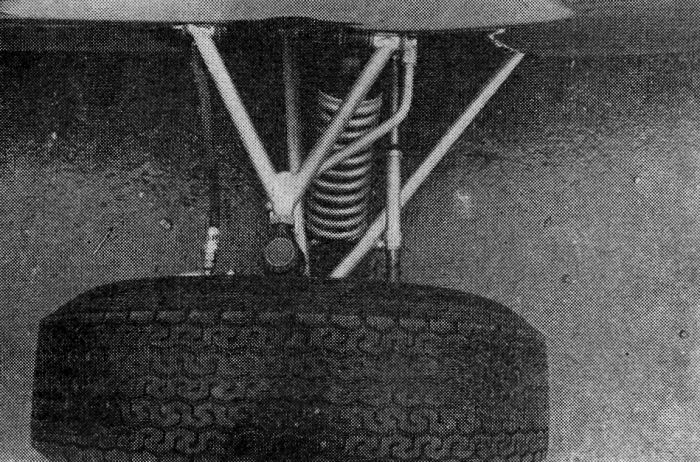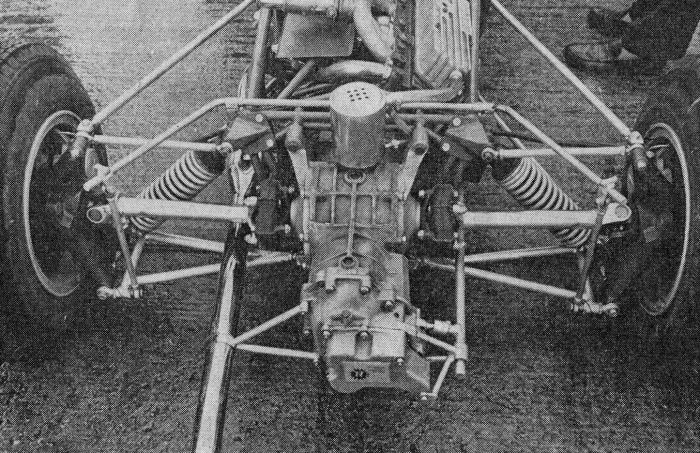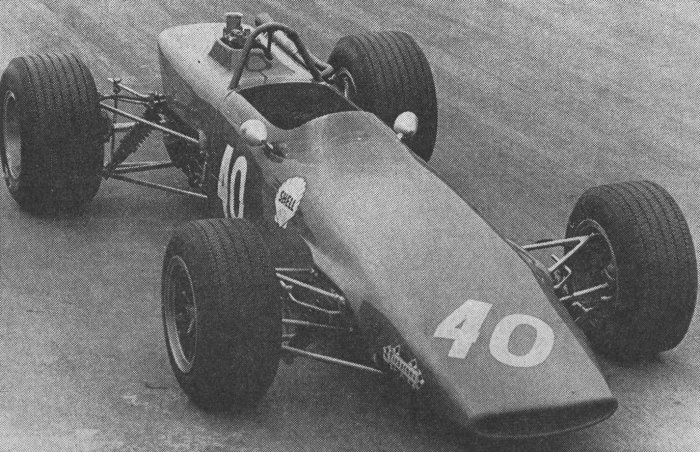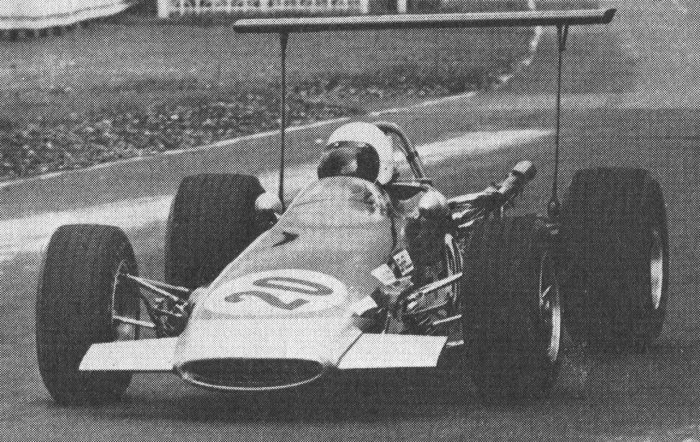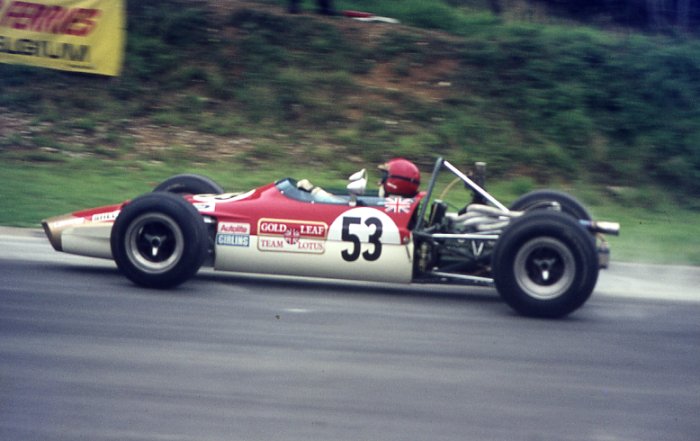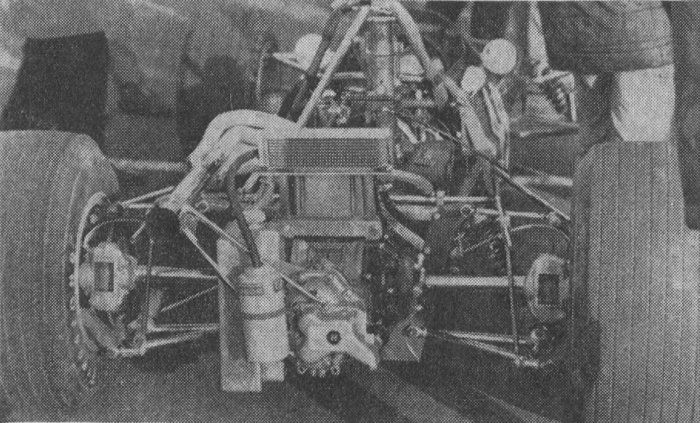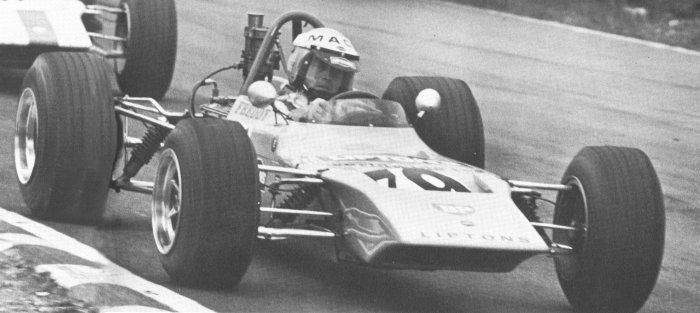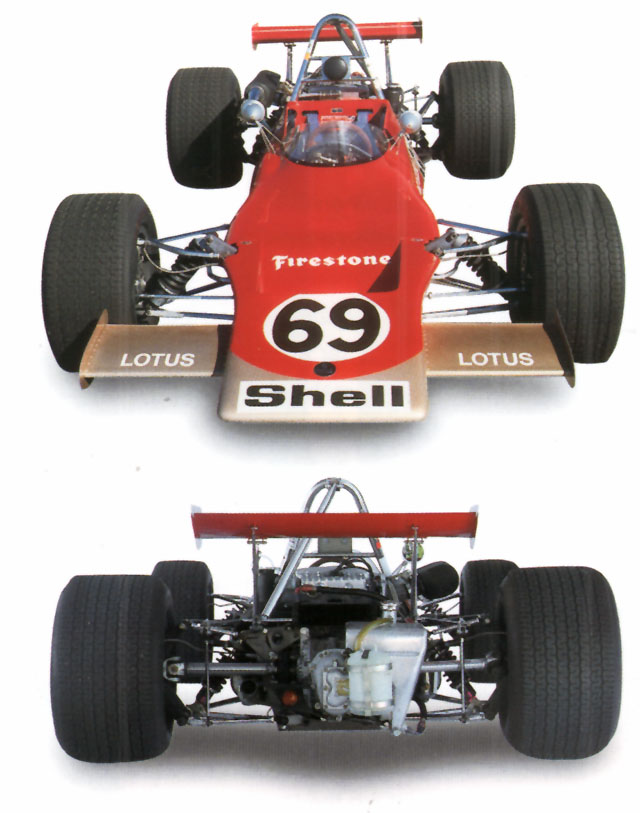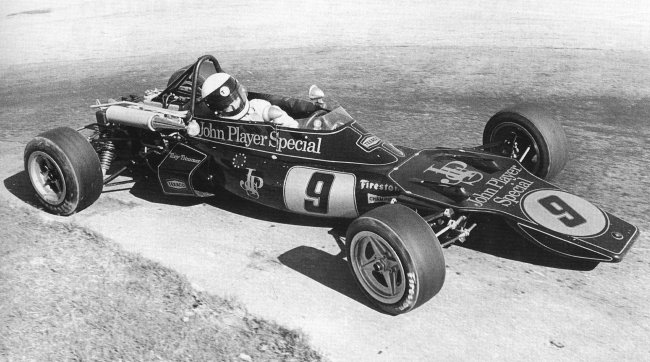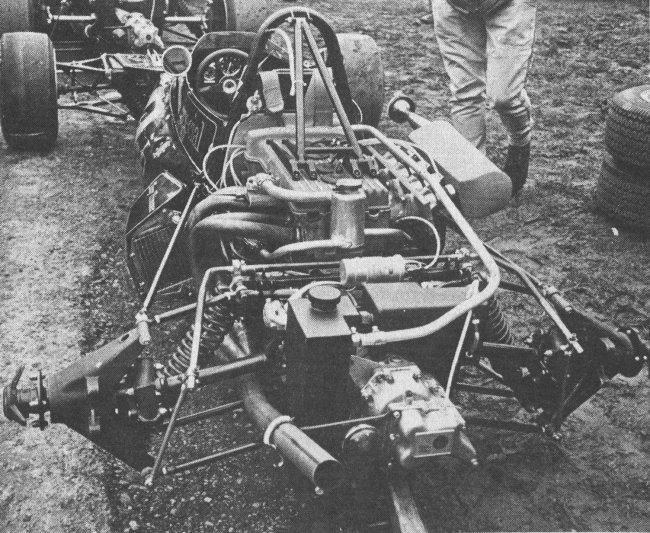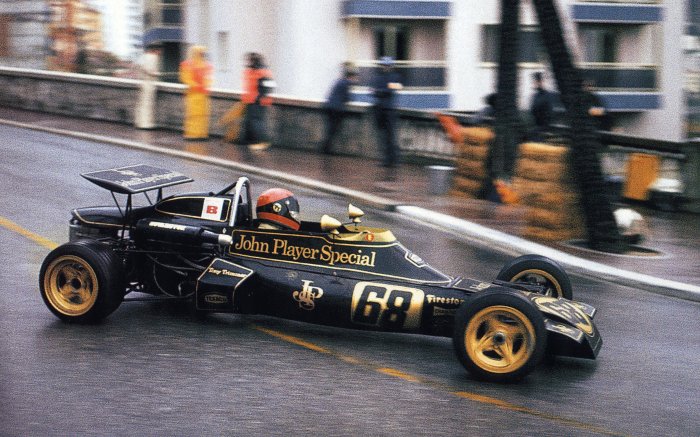Lotus
1964
1965
1966
1967
1968
1969
An entirely new design for 1969, the Dave Baldwin designed 59. It was a dual purpose F2/F3 spaceframe chassis composed of square tubing. Suspension was the familiar double wishbone, outboard springs and dampers at the front with top link, reversed lower wishbone and twin radius rods at the rear. Triumph Herald uprights were used at the front with cast-magnesium units the rear. Wheels were cast magnesium with a knock-on centre-lock fitting. The oil tank, pump, cooler and catch-tank were all sited over the Hewland gearbox.
Wheelbase: 92.5 ins.
Track: front & rear 56 ins.
The 59 first appeared at the Brands Hatch Boxing Day meeting, actually the 27th December 1967. After overcoming some early season problems with spring rates and the oil system the car proved a success, its chunky body hampered it a little on fast circuits but it had a reputation for putting the power down very well. Most successful driver was an up-and-coming young Brazilian named Emerson Fittipaldi, a string of nine wins saw him take the UK Lombard Championship.
1970
1971
1972
According to Lotus publicists the 73 was the F3 answer to the F1 World Championship winning 72. It was built purely for use as a works car and was officially designated a “John Player Special”. Early design work was by 72 designer Maurice Phillippe before he left Lotus and it was originally intended to be a F2 car. The design was finalised by Dave Baldwin and Martin Wade. Like its F1 big brother the 73 had a bathtub monocoque with the engine acting as a stressed member attached via a tubular framework. At the front a tubular sub frame carried the rack and pinion steering, inboard front brakes, rising rate suspension with fabricated double wishbones with outboard coil springs and dampers. Rear suspension was via a single upper link, twin parallel lower links and twin radius rods, the whole design was based on the 59/69 series. Coil springs/dampers were outboard, brakes inboard.
Early season results were good with Trimmer winning at Mallory and coming second at Monaco but ultimately the car was too complex to be set up quickly in the short F3 race days and the car faded as the season progressed. Additionally the impression was that Lotus weren’t really interested in F3 and that some of the JPS F3 budget ended up in the F1 coffers.
A modified version, the 73B was prepared for 1973 but lack of a sponsor meant Lotus never raced it. The cars were sold to Dr Joseph Ehrlich in 1975 who entered one in a race at Monza as an Ehrlich-Lotus, driven by Patrick Neve, it retired after failing to feature.
Drivers (N.B. Race reports in the early sixties often didn’t specify the chassis type so details are necessarily uncertain)
1964
31
Rodney Banting, Richard Burton, Piers Courage, Jörgen Ellekaer, John Fenning, Pierre Gelé, Evert Jan Groen, Freek Dudok van Heel, Martin Kaye, David van Lennep, “Franz Müller” (Roman Dirschl), Georges Rossetti, Sverrir Thoroddsson, Jonathan Williams.
27
Malcolm Angood, Jean-Paul Behra, John Berry, Roland Binder, Bruno Deserti, Franz Dörfliger, Bruce Eglinton, Simon de Lautour, Melvyn Long, Hans Maasland, Luigi Malanca, Alberico Passadore, Malcolm Payne, David Porter, Harry Stiller, Barry Wood, Philippe Vidal.
22
Georges Ansermoz, Pino Babbini, Guglielmo Bellasi, John Berry, Luigi Bettiol, Bernard Collomb, Franco Conti, Piers Courage, Paul Craven, Jörgen Ellekaer, John Fenning, Franco Ghezzi, Kai Godenhjelm, Brian Hart, Henri Julien, Jens-Christian Legarth, Alain Leguellec, Michel Looser, Jean-Pierre Muller, Jack Pearce, Jacques Pouzet, Georges Rossetti, Stefan Sklenar, Jonathan Williams, Walter Wüst.
20/22
Mike Herbertson.
20
Albert Achinger, Norberto Bagnalasta, Jean Bruyère, Ralph B.de Laforest, Dieter Lanzerath, Charles Lucas, Otto Lux, Jean-Pierre Muller, Franco Pigozzi, Jacques Pouzet, Georges Rossetti, Keith St John.
18
Jean Audhuy, Christian Berger, Jean Bruyère, Chicard, Kurt Dernen, Patrick Dupin, Horst Görs, Jean-Marie Guyot, Georges Héligoin, Jean-Louis Mise, Vincent Palmaro, Johnny Rives, Claude Robert, Claude Swietlik, Olivier Turcat, Karl Untersteggaber, Richard Weber.
?
Malcolm Angood, Brian Barton, Daniel Cerisier, Franco Conti, Yves Deprez, Ray Dilley, Thierry van Eyll, Len Gibbs, Toni Hildebrand, Albert McMillen, Alessandro Rigamonti, “Thierry”, Walter Treser, Giuseppe Vanaria.
1965
35
Bob Bondurant, John Cardwell, Adrian Chambers, Brian Hart, Freddy Kottulinsky, Melvin Long, John Miles, Filippe Nogueira, Ray Parsons, Peter Revson, “Jorge S”, Alban Scheiber, Roby Weber.
34
Dieter Lanzerath.
32
John Cardwell, Francesco Ghezzi, Harry Stiller.
31
Derek Bell, Paul Deetens, Ray Hills, Ole Jörgensen, Tony Lanfranchi, Morris Nunn, Leif Persson, Georges Rossetti, Giuseppe Vanaria, Adam Wyllie.
27
Roland Binder, Sean Brady, Walter Flückiger, Patrice Gransart, Tonio Hildebrand, Hans Maasland, Harry Stiller.
22
Rodney Banting, Guigliemo Bellasi, Alessandro Braga, Giouse Butti, Walter Flückiger, Kai Godenhjelm, Ole Jörgensen, Jörn Qviste, Georges Rossetti, Tom Trana.
20/22
Mike Herbertson.
20
Romolo Baston, Raymond Sodreau.
18
A. Prince, Hans Nilsson.
?
Francois Chevalier, Edwin Dawson, Peter Derré, Luigi Foschi, Carmelo Genovese, Peter Gethin, Patrice Gransart, Willi Keufen, Dieter Lanzerath, Ray Parsons, Malcolm Payne, Gunnar Pedersen, Aldo Pessina, Luigi Petri, Boley Pittard, Walter Wüst.
1966
41
Derek Bell, Lars Bjuhr, Jean Blanc, John Cardwell, Gunnar Carlsson, Piers Courage, Andrew Cowan, Teddy Dawson, Tony Dean, Cacho Fangio, “Geki” (Giacomo Russo), Francesco Godia, Nick Gold, Egert Haglund, Brian Hart, L Hawkins, John Hine, David Hobbs, Tetsu Ikuzawa, Bill Ivy, José-Maria Juncadella, Emil Knecht, Simon de Lautour, Melvyn Long, Wim Loos, Charles Lucas, Chris Moore, Hans Nilsson, Morris Nunn, Eric Offenstadt, Jackie Oliver, Vincent Palmaro, Malcolm Payne, Roy Pike, Peter Revson, Alex Soler-Roig, Rob Slotemaker, Harry Stiller, Thierry Tilmant, Peter Welstead.
35
Walter Flückiger, Keith Greene, Brian Hart, L Huerta-Garcia, Brian Jordan, Freddy Kottulinsky, Jochen Neerpasch, Colin Priddey, Karl von Wendt, Andy Wilkinson.
32
Jaime Martinez.
31
Tony Broster, Roy Cook, Ken Crook, Teddy Dawson, Bengt Ekström, Peter Fattorini, Len Gibbs, Mike Heathcote, Brian Jordan, John Hartle, John Lindsay, Ken Luscombe-Whyte, Mike Potter, Jeff Roberts, Simon Sherman, Steve Thompson, David Wragg.
27
Roland Binder, Werner Jörgensen.
22
Tony Bracegirdle, Tony Broster, Giosue Butti, Kaj Godenhjelm, Alessandro Guidetti, Gabriel Lacoste, Chris Lewis, Luigi Malanca, John Peake, Jörn Qviste, David Wragg.
20
John Lindsay, Betty Peters, Heinz-Dietmar Riedinger.
18
Thorkild Thyrring.
?
Jean-Pierre Beynac, Alessandro Braga, Antonio Braga, Capozzi, Foresti, Giancarlo Gagliardi, Stefan Gelmar, Genovese, Francesco Ghezzi, “Giagi”, A. Guidetti, Olavi Kuikka, Gabriel Lacoste, Dieter Lanzerath, Hasse Nilsson, Saint-Michel, Saverio Salerno, Hans Sjosted, Andrea Tosi.
1967
41C
Vladimír Hubácèk, Freddy Kottulinsky.
41 (some may be the 41C chassis)
Albert Badan, Giancarlo Baghetti, Jean-Claude Beynac, David Bickel, Roland Binder, Jean Blanc, John Cardwell, Chris Cox, Peter Crossley, Mac Daghorn, Jürg Dubler, Bo Eriksson, Nasif Estefano, John Fenning, Malcolm Fletcher, Alain Franceschi, Peter Gaydon, “Geki” (Giacomo Russo), Ramon Griffoll, Cliff Haworth, John Hine, Vladimir Hubacek, Emil Knecht, Brian Jordan, “Josse”, John Kendall, Freddy Kottulinsky, Robert Lamplough, Freddy Link, Charles Lucas, Carlos Martin, John Miles, Chris Moore, John Netherwood, Hans Nilsson, Morris Nunn, Eric Offenstadt, Andrew Page, José-Maria Palomo, Jaime Piera, Roy Pike, Comte Adam Potocki, Gilbert Salles, Jaime Samsò, Alex Soler-Roig, Georges Taquet, Javier de Vilar, Peter Welstead.
35
José Juncadella, Dieter Lanzerath, Freddy Link, Ernst Maring, Ove Nicklasson, Eric Offenstadt, Chris Williams.
32
Brian Jones, Brian Jordan.
31
Bengt Ekström, Peter Farrer, Bernard Unett, Leif Wikander.
27
“Kirke”, Tim Stock.
22
A Bracegirdle, Tim Schenken.
20
Heikki Heidenstrauch, Börje Lindberg.
18
Bob Howlings.
?
Franco Foresti, Eugen Kiemele, Jean-Paul Moussier.
1968
59
John Miles.
51
Jac Nelleman.
41X
John Miles.
41C
Ken Crook.
41 (some may be the 41C chassis)
Albert Badan, Eugenio Baturone, Jean-Pierre Beynac, Roland Binder, Jean Blanc, Alain Cheval, Paul Cure, Leif Englund, Lennart Engström, Malcolm Fletcher, Josef Frei, Carlos Giro, Freddy Kottulinsky, Freddy Link, Morris Nunn, José Palomo, Lars-Eric Salé, Richard Scott, Georges Taquet, Philippe Vidal, Staffan Wahlström.
35
Roland Binder, Tony Birchenhough, Paul Fischer, Freddy Kottulinsky, Freddy Link, Ernst Maring, Bengt Rådmyr, Åke Roslund, Paul Tucom.
22
Willi Deutsch.
20
Willi Deutsch.
?
Björn Öhrman, Vladislav Ondrejik, Bengt Rådmyr, Per-Owe Söderberg.
1969
59B
Tetsu Ikuzawa.
59
Mike Beckwith, Bev Bond, Lars Elgin, Emerson Fittipaldi, Tetsu Ikuzawa, Freddy Kottulinsky, Matti Lamminen, François Mazet, Morris Nunn, Ronnie Peterson, Roy Pike, Andy Sutcliffe, Dave Walker.
51
Ernst Ungar.
41B
Francois Humbert.
41
Vladimir Hubacek, Jörg Kissling, Vladislav Ondrejik, Bengt Radmyr, Peter Rosenmaier, Lars-Erik Sale, Mike Watkins.
35
Tony Birchenhough, Paul Fischer.
1970
59A
Sten Axelsson, Bev Bond, Wilson Fittipaldi, James Hunt, Fritz Jordan, Freddy Kottulinsky, Carlos Pace, Dave Walker.
59
Sten Axelsson, Bev Bond, Claude Bouroignie, David Cole, Wilson Fittipaldi, James Hunt, Per K:son Kjellberg, Freddy Kottulinsky, Carlos Pace, Bengt Rådmyr, Andy Sutcliffe, Tony Trimmer, Ole Vejlund, Dave Walker, Tom Walkinshaw.
41B
Michel Richard.
41
Bengt Rådmyr, Mike Watkins.
35
Paul Fischer.
?
Rolf Gröndahl, Vladimir Hubacek, Vladislav Ondrejik.
1971
69
Ian Ashley, Thomas Betzler, Guisseppi Bianchi, Gerry Birrell, Claude Bourgoignie, Freddy Kottulinsky, Manizio Levi, Richard Longman, Alan McCully, Manfred Möhr, Dave Morgan, Giancarlo Naddeo, Fernando Natividade, Fabrizio Noe, Rikki von Opel, Gerold Pankl, Bengt Radmyr, Andy Sutcliffe, Dave Walker, Sven Wingaard, Geddes Yeates.
59A
Wilson Fittipaldi, Fritz Jordan, Carlos Pace, Tony Trimmer, Dave Walker.
?
Paul Fischer, Sigi Hofmann.
1972 73
Tony Trimmer, Bernard Vermilio,
69
Ross Ambrose, Carlo Breidenstein, Alan Edgar, Harald Ertl, Roger Keele, Günter Kölmel, Freddy Link, Lella Lombardi, Barrie Maskell, Ernesto Neves, Bruno Pescia, Bengt Radmyr, Gerhard Witti, Geddes Yeates.
1973 69
Malcolm Bohm, Carlo Breidenstein, Günter Kölmel, Gaudenzio Mantova, Klaus Scholtyssek.
1974 69
Carlo Breidenstein, Günter Kölmel.
1975
73B
Patrick Neve.
? (Listed as a Lotus 3)
Peter Rössler.
